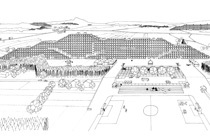
|
Josef Lackner_Habitable Landscapes OPENING: SEPTEMBER 14. 2011, 6pm EXHIBITION: SETPEMBER 15. 2011 - OCTOBER 03.2011 Speakers: Dietmar Steiner, director of the Az W: welcome address Monika Platzer, curator of the exhibition, Az W: introduction Otto Kapfinger, architecture critic: on the work of Josef Lackner "The architect must plan homes that he would also like to live in himself. Everything else is inadmissible." (Josef Lackner) Josef Lackner (1931–2000) numbers among the most significant architects of the Austrian postwar generation. Educated at the Vienna Academy of Fine Arts under Clemens Holzmeister (1949–1952) and following a number of years gaining practical experience at a range of German architecture offices, Lackner worked independently from Innsbruck. Church building played a key role in Lackner's work – the churches at Neu-Arzl/Innsbruck (1958–1960), in Völs (1965–1967) as well as the Glanzing presbytery in 1190 Vienna (1968), in particular, are among the classics in the history of architecture. Alongside sacral buildings, housing projects are among the core briefs in Lackner's oeuvre, which is presented in an exhibition for the first time on the basis of numerous models from the Az W collection. The first works from the 1960s were still completed under the influence of Classical Modernism, while at the same time Lackner engaged critically with the realities of planning in his time. Projects like the Kaiser-Max-Strasse housing complex (in Hall, Tyrol) or the B85 housing complex (in Innsbruck) bear testimony to the intensity of his engagement with the housing block as a metropolitan manifestation. The 1967 Anti-Stadt (Anti-City) in Moos, Switzerland, can be understood as a critical contribution to counter the functional development of metropolises. People's still current yearning for a house of their own in the countryside provided Lackner with over 90 housing projects, of which over 60 commissions were for single-family homes, primarily completed in Tyrol. Lackner based the house types on structural, environmental and typographical givens. The wide diversity of the houses, which are frequently orientated in formal terms on elementary geometry is interesting in this context. The models on display from the collection of the Architekturzentrum Wien (Josef Lackner's estate has been housed at the Az W since 2005) are working tools that demonstrate Lackner's intense engagement with spatial, sculptural and topographical issues, and are intended to provide an insight into his approach as an architect. Josef Lackner would have been 80 this year – the Az W is taking this jubilee as an opportunity to pay tribute to one of the great figures of Austrian architecture. ADDITIONAL EVENTS a_showcase 17: Josef Lackner_House Calls Wed 14.09.2011, 6pm (followed by the exhibition opening) Az W Podium & Neue Halle, admission free guests: Monika Abendstein, Peter Hellebart, Christof Lackner moderated by Monika Platzer, Az W To coincide with the exhibition 'Josef Lackner_Habitable Landscapes', a_showcase presents 'visits' to a range of apartment buildings. The interior life of his buildings is like a casing fitted to suit the personal needs of the occupants, and not immediately appreciable at first glance. In many instances the specific use of materials homogenise the space, while intense colourful accents and the softness of the rounded shape of the fitted furnishings frequently contrast with a rational external appearance. The surfaces and the atmosphere of the spaces convey a sensuality and sense of security that go well beyond the usual cliché of cosiness. The Long Night of the Museums Sat 01.10.2011, from 6pm The Long Night of the Museums also provides everybody interested in architecture with an opportunity to visit the exhibition 'Josef Lackner_Habitable Landscapes' until late into the night! Curator of the exhibition: Monika Platzer, Az W Exhibition graphic design: Peter Duniecki Designstudio |
 |
|
© Az W |
|
Press page Current events Past events Dates: a_showcase 17: Josef Lackner_House Calls Josef Lackner_Habitable Landscapes Downloads: PRESS RELEASE: CV Josef Lackner PRESS RELEASE: Josef Lackner_Habitable Landscapes Information: Ines Purtauf Tel.: +43 (1) 522 31 15 - 25 Fax: +43 (1) 522 31 17 Email: purtauf@azw.at |
| © Architekturzentrum Wien 2025 |
||



